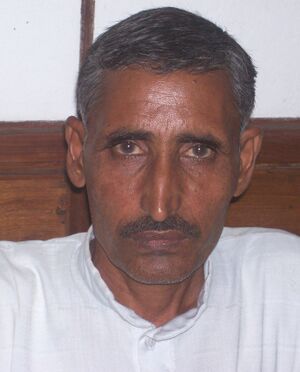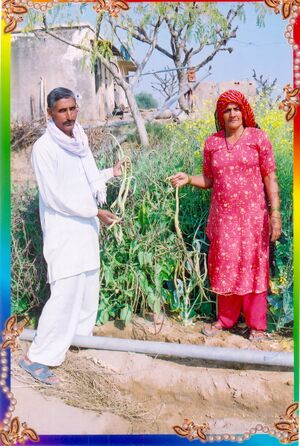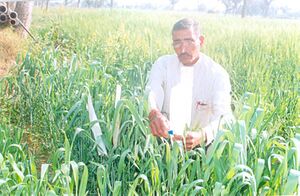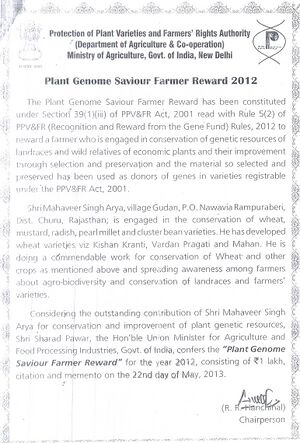Mahavir Singh Arya
| लेखक:लक्ष्मण बुरड़क, IFS (R) |

Mahavir Singh Arya , born in 1951 in Jakhar family, in a remote village Gudan in Rajgarh tahsil of Churu district in Rajasthan, fought poverty to grow up into a successful Innovative and Enterprising farmer. With keen observation and tremendous hard work, he has today developed numerous varieties of wheat and mustard.
Family life

He could not continue his studies beyond class tenth on account of weak financial condition of the family. His father was a freedom fighter well known as an enterprising farmer in the region. He had good knowledge of herbs and traditional methods of treatment also and used to provide treatment to patients, free of cost.It was during the British rule that their fields were confiscated and they were left with no land. Today he has less than a hectare land still he is famous in his region for getting bumper crop even from this small holding and for his innovative agricultural practices. Father of six, Arya admits that it has been difficult for him to sustain his family through the output generated from this land but he is determined to work out ways to maximise his yield by experimenting. Apart from working in his own field, he also works for the all round development of this region.
He has a small but beautiful home in the village; has married off three of his daughters and rest of the children are studying at school.
Enterprising farmer

Already famous in his village and surrounding area as an enterprising farmer, seed producer and a simple man, Arya still puts in lots of efforts to develop new varieties of plants.Facing problems in his own village due to acute scarcity of water, he still tries and works in other farmer's fields, some of whom are in neighboring villages, which itself is a huge task. This way he has managed to preserve some of the varieties developed by him. Even his request, to the Member of Parliament of his area and other officials, regarding the scarcity of water has not given any results.
Developed new varies of wheat and mustard
Mustard: In 1985, after visiting Hisar and seeing the crop varieties there, Arya, sowed T-59 variety of mustard in his field for the first time and then later in the same year he sowed the Golden variety seed brought from Delhi.It was during his visit to Hisar, where he saw the crop-growing pattern and learned the way crosses were made between varieties and selection was done. He tried crossing two varieties he had, T-59 and Golden. The result was a new variety, which was named Sundari. Inspired by the success he got in his efforts, his interest in breeding grew and thereafter he made a point to visit various research institutions and universities, to keep himself updated. With time his knowledge and experience increased, he kept on learning tips from these places and repeated them experimentally in his field. His efforts paid dividend, as he was able to develop more than 10 new varieties of mustard by crossing the varieties available in and around Delhi.
Wheat: In the year 1987, he met a Muslim trader from Uttar Pradesh who incidentally visited his village. Through him, he came to know about a tall, high yielding local variety of wheat growing in the region where the trader belonged. He requested him to get some seeds for him the next time he came. The trader obliged him by bringing for him the seeds the next time when he visited his village.He planted the seeds in small portion of his field and crossed it with a variety Sonalika he was already using. The next year, in the first generation of the cross, the farmer observed plants, which were taller, had bold grains and were resistant to disease. He selected plants with the desired characteristics like height of the plant, resistance to disease, etc., year after year and in 1990, developed a variety Mahavir Kisan Mahan with stable characteristics. In the same way, he kept on crossing varieties obtained from different regions and various cooperatives with other local varieties and successfully developed more than fifteen varieties of wheat. The general process he followed while developing new varieties is briefly mentioned
- a) Selection of two varieties (based on quality and characteristics of interests
- b) Crossing the two varieties
- c) Selection of plants with best quality and characters in F1 followed by selection for same characteristics for three-four generations (F2 - F6)
- d) Naming and isolation of 'stable' varieties in terms of characteristics
- e) Distributing them to others for sowing.
Crossing many local varieties, he developed many varieties of mustard, which include Mahavir Kishan Chandravarni, Mahavir Kishan Pittavarni, Mahavir Kishan Kanka, Mahavir Kishan Harsh, Mahavir Kishan Sunahari. The maturity period of all these varieties varies from 130 to 150 days and the yield from 18 quintals per hectare to 24 quintals per hectare. All the varieties are disease resistant and high yielding.
Similarly, he has developed many wheat varieties too. Mahavir Kishan Mahan, Mahavir Kishan Vardan, Mahavir Kishan Kranti, Mahavir Kishan Vikash, Mahavir Kishan Pragati varieties are the prominent ones among them. The maturity period of all varies from 135-160 days, in case of Mahavir Kishan Pragati variety, the period is 95-110 days as it is a short duration variety. This particular variety is the only dwarf one among all, which are tall varieties. The yield of these varieties varies from 40-80 quintals per hectare.
Mahavir Singh Arya's daily routine involves spending most of the time in his field, selecting plants and crossing them. He is ably assisted and supported by all the members in his family. It is only when he has to uproot and discard many plants while making selection he has to face some resistance from his family. They complain about throwing those plants away, which have been produced after hard labour and care. He then explains the reason behind the selection process to them, in the process making them knowledgeable and passing on his experience too. Possessing good experience in agriculture, he is invited by other farmers for guidance and assistance, so, much of his time is spent in traveling too and this invokes criticism from his wife, as he is not able to devote enough time to the family. However, the family understands his devotion to the cause and supports him in his activities. They wish he were able to help maximum people and make a name for himself and as a result making them proud too. They know he has been working hard for the past many years and hope that he becomes famous one day. Keeping their expectations firmly grounded, they wish to have a tube well in the village so that everyone is benefited and they are able to carry on their own research work, without any hindrance.
Plant Genome Saviour Farmer Reward 2012


The Plant Genome Saviour Farmer Reward has been constituted under Section 39(1 )(iii) of PPV&FR Act, 2001 read with Rule 5(2) of) PV&FR (Recognition and Reward from the Gene Fund) Rules, 2012 to reward a farmer who is engaged in conservation of genetic resources of landraces and wild relatives of economic plants and their improvement throuqh selection and preservation and the material so selected and preserved has been used as donors of genes in varieties registrable rnder the PPV&FR Act, 2001.
Shri Mahaveer Singh Arya, village Gudan, P.O. Nawan, Via: Rampuraberi, dist. Churu, Rajasthan; is engaged in the conservation of wheat, mustard, radish, pearl millet and cluster bean varieties, He has developed wheat varieties viz Kishan Kranti, Vardan Pragati and Mahan. He is doing a commendable work for conservation of Wheat and other crops as mentioned above and spreading awareness among farmers about agro-biodiversity and conservation of landraces and farmers' varieties.
Considering the outstanding contribution of Shri Mahaveer Singh Arya for conservation and improvement of plant genetic resources, Shri Sharad Pawar, the Hon'ble Union Minister for Agriculture and Food Processing Industries, Govt. of India, confers the "Plant Genome Saviour Farmer Reward" for the year 2012, consisting of Rs. 1 lakh, citation and memento on the 22nd day of May, 2013.
- R.R.Hanchinal
- Chairperson
Advocate of organic farming and traditional treatment
He is an advocate for the use of organic method of farming and claims that he has never used any inorganic fertilizer in his field and still he has managed to generate good yield using organic manures. The palms of his hands bear a testimony to his hard work all these years.
Herbal and traditional treatment: Apart from experimenting and developing new crop varieties in the field, Arya is also involved in herbal and traditional treatment of patients of his region; knowledge of which he has inherited from his father and some of which he has developed through his own interest and enterprise.
Contact Details
Address : Mahavir Singh Arya, Village: Gudan, P.O.: Nawan, Via: Rapura Beri, Tahsil: Rajgarh, District: Churu, Rajasthan, PIN: 331301,
Phone: 01569-313267
Mob: 07891132139, 08769030339, 09461932854
महावीरसिंह आर्य का जीवन परिचय
महावीरसिंह आर्य का जन्म चूरू जिले में राजगढ़ तहसील के गाँव गुडान में संवत 2006 में फाल्गुन माह में फुलरिया दूज के दिन हुआ। इनके पिता का नाम श्री दोदराम आर्य और माता का नाम श्रीमती बूजी है। इनकी पत्नी का नाम राजबाला है।
महावीरसिंह आर्य ने प्राथमिक स्कूल की पढ़ाई निकट के गाँव नवां से की और आठवीं की परीक्षा भिवानी जिले में लुहारू तहसील के गाँव आर्यनगर से की।
इनके पिताजी श्री दोदराम आर्य स्वतंत्रता सेनानी थे जिन्होंने जागीरदारों के खिलाफ आजीवन संघर्ष किया। लुहारू नवाब के विरुद्ध आन्दोलन करने पर इनके पिताजी लाठी चार्ज के शिकार हुए। राजगढ़ में शीतला माता के मंदिर पर कांग्रेस की स्थापना के अवसर पर वे लाठीचार्ज में घायल हुए। उन्होंने नारा दिया कि जान दे देंगे पर झंडा नहीं देंगे।
जागीरदार के खिलाफ आन्दोलन करने के कारण पिताजी श्री दोदराम आर्य की जमीन छीन ली गयी थी। वर्तमान में महावीरसिंह आर्य के पास केवल 3 बीघा 5 बिस्वा जमीन है जिस पर वे पूर्ण रूप से निर्भर हैं। उन्होंने वर्ष 1974 में एक ट्यूबवेल करवाया और सन 1982 से लगातार कृषि के क्षेत्र में अनुसन्धान कर रहे हैं। अनुसन्धान की प्रेरणा उनको तब मिली जब वे रेडियो पर तत्कालीन प्रधानमंत्री लाल बहादु शास्त्री जी का भाषण सुन रहे थे।
कृषि अनुसन्धान और विस्तार
महावीरसिंह आर्य वर्षों से अपने खेत में खेती में नए-नए अनुसन्धान करते आ रहे हैं। इसके अंतर्गत परागण द्वारा रबी में गेहूं, सरसों व सब्जी में मूली के सोगरी पर प्रयोग कर नई किस्में तैयार की हैं। गेहूं की पांच , सरसों की पांच नई किस्मे तैयार की हैं। मूली की ढाई से साढ़े तीन फीट लम्बी सोगरी की किस्में तैयार करके किसानों तक पहुंचाई हैं। इससे किसान गुणवत्ता युक्त अधिक उत्पादन की फसलें ले रहे हैं। महावीर सिंह द्वारा गेहूं की 50, सरसों की 22, मूली की सोगरी की 20 किस्मों पर शोध जारी है। सरसों की दस किस्में पीले मोटे दाने वाली तथा शलजम की एक किस्म तैयार की गयी है। बाकि सभी काले रंग में किस्मे हैं। महावीर सिंह द्वारा बाजरे की 17 किस्मों पर तथा ग्वार की 4 किस्मों पर शोध जारी है। बाजरे की अधिक उपज देने वाली गुणवत्ता युक्त और अधिक चारा देने वाली फसल पर शोध चल रहा है। महावीर सिंह कृषि शोध के साथ किसानों को जानकारी देकर इन तकनीकों का विस्तार भी करते हैं।
महावीर सिंह समय-समय पर अपने खेत पर शिविर लगाकर किसानों को भूमि की तैयारी से लेकर अनाज भण्डारण की जानकारी किसानों को देते हैं। वे गर्मियों में गहरी जुताई, उन्नत किस्म के बीज, बुवाई से पहले बीज उपचार की विधि तथा आधुनिक तरीके से खेती करने की जानकारी देते हैं। भारतीय कृषि अनुसन्धान संसथान पूसा, नई दिल्ली के कृषि वैज्ञानिक तथा राष्ट्रीय भैंस अनुसन्धान हिसार की टीमें आकर कई सालों तक कृषि और पशुपालन सम्बन्धी जानकारी दी गयी।
फसल गुणवत्ता में सुधार
महावीर सिंह द्वारा अभी तक रासायनिक खाद का प्रयोग नहीं किया गया है। जैविक खाद तैयार कर गुणवत्ता बढ़ाई और अधिक पैदावार ली। फसलों पर लगने वाले कीटों तथा रोगों की रोकथाम जैविक विधि से कर अच्छी गुणवता की फसलें तैयार की जा रही हैं। किसानों को आधुनिक तकनीक और वैज्ञानिक विधि से खेती करने के लिए तैयार किया जा रहा है। कृषि अनुसन्धान केंद्र फतेहपुर के सहयोग से गाँव में 18 किसानों को डाक्टरों की देख-रेख में प्रदर्शनी लगा कर अलग-अलग तकनीक की जानकारी दी गयी। इसमें गेहूं व जौ की उन्नत किस्में लगाई गयी।
महावीर सिंह बाल्यकाल की गरीबी से दूर आज एक सफल किसान हैं। वे जैविक-खेती के पक्षधर हैं तथा अपने छोटे से खेत से अधिक पैदावार प्राप्त करते हैं। गौरतलब यह भी है कि इन्होने आजतक रासायनिक खाद का उपयोग नहीं किया है। अपनी हिसार यात्रा के दौरान इन्होने देखा कि वहां किसान पादप-प्रजनन में काफी बढ़-चढ़कर हिस्सा लेते हैं। इससे इन्हें भी पादप प्रजनन में रूचि हो गयी। तब इन्होने सरसों की T-59 और गोल्डन प्रजाति के बीच अभिजनन करवाया और प्राप्त नई प्रजाति को 'सुंदरी' नाम दिया गया। इसके बाद से अब तक इन्होने सरसों की कम से कम 10 प्रजातियाँ विकसित की हैं। इन सभी प्रजातियों का परिपक्वन 130 से 150 दिनों में हो जाता है और प्रति हेक्टर 18 - 24 क्विंटल तक का उत्पादन होता है। ये सभी प्रजातियाँ रोगप्रतिरोधक क्षमता तथा अधिक पैदावार वाली हैं। इनके द्वारा विकसित गेहूं की अनेक प्रजातियों का परिपक्वन काल 135 - 160 दिनों का तथा पैदावार 40-80 क्विंटल प्रति हेक्टर होती है। [1]
बागवानी : महावीर सिंह द्वारा बागवानी के क्षेत्र में भी सुधार के प्रयास किये गए। उनके द्वारा ग्रामीणों को उत्तम किस्म के पौधों को तैयार करना तथा ग्राफ्टिंग से उन्नत किस्म के पौधे लगाने के लिए प्रेरित किया गया। वे स्वयं किसानों के खेतों पर कलम लगाकर किस्म सुधार का कार्य करते हैं।
पशुधन विकास
महावीर सिंह द्वार पशुधन के अंतर्गत अच्छी नस्ल को बढ़ावा देने के लिए लोगों की रुढ़िवादी धारणा को तोड़ते हुए पहली बार कृत्रिम गर्भाधान करवाकर पशु नस्ल सुधार कार्य किये गए। किसानों को कृत्रिम गर्भाधान के लिए जागरूक किया गया। इस कार्य में उनको विरोध का भी सामना करना पड़ा । महावीर सिंह द्वार मुर्रा नस्ल का एक भैंसा तैयार किया गया जिससे उनके अपने गाँव में तथा आस-पास के गाँवों के किसानों को लाभ पहुँचाया गया। पशुधन को बिमारियों से बचाने के लिए समय-समय पर टीकाकरण करवाया गया। महावीर सिंह द्वार कृत्रिम गर्भाधान के लाभों से ग्रामीणों को अवगत कराया गया। महावीर सिंह स्वयं मुर्रा नस्ल की भैंस, मुर्रा नस्ल का भैंसा, जर्सी नस्ल की गाय तथा अन्य छोटे पशु पालते हैं और इनसे होने लाभों की जानकारी ग्रामीणों को देते हैं।
जैविक खाद तथा बायो गैस
महावीर सिंह द्वार अपने खेत में बायो गैस (गोबर गैस), सुपर कम्पोस्ट, वर्मी कम्पोस्ट तथा कुर्डी की खाद तैयार करके उनके अलग-अलग प्रयोग किये गए और उनसे होने वाले लाभों की जानकारी किसानों को दी गयी। उनके द्वारा किसानों को बायो गैस लगाने के लिए जागरूक किया गया ताकि इसकी सैलरी से किसान खेती करके लाभ उठा सकें और गैस सिलेंडर के पैसे बचा सकें। गांव वालों को समझाया गया कि इससे पर्यावरण प्रदूषण कम होगा और पेड़ों की कटाई रुकेगी।
पुरस्कार
- किसान वैज्ञानिक बने: परंपरागत ज्ञान से नई किस्मों को उपजाने वाले राजस्थान के पांच किसानों को किसान वैज्ञानिक का दर्जा दिया गया है। राष्ट्रीय कृषि विज्ञान केंद्र पूसा, नई दिल्ली में नेशनल इनोवेशन फाऊंडेशन अहमदाबाद और किसान पौध किस्म अधिकार प्राधिकरण के संयुक्त तत्वाधान में आयोजित बैठक में यह दर्जा दिया गया है। इसके साथ इनको 50 -50 हजार की राशि भी दी गयी है। इनमें से चार शेखावाटी से और एक जयपुर जिले से है। ये किसान हैं - जगदीश प्रसाद पारीक नि. अजीतगढ़ जिला सीकर गोभी के लिए, मानाराम पुत्र रामकुमार सिंह नि. सांवलोदा जि. सीकर प्याज के लिए, देवाराम गढ़वाल नि. जेवली जिला सीकर बाजरा के लिए, महावीरसिंह आर्य नि. गुडान जिला चूरू गेहूं के लिए, गंगा राम कीर जिला जयपुर टिंडा की नई किस्म विकसित करने के लिए यह सम्मान मिला है। किसान पौध किस्म अधिकार प्राधिकरण ने अपने निश्चित मानदण्डों पर इन किस्मों का परिक्षण किया गया और इन्हें श्रेष्ठ किस्म माना। इन नई किस्म के बीजों को किसान के नाम से पंजीकरण करके किसानों के अधिकार को सुरक्षित कर दिया है।[2]
- महावीर सिंह को कृषि क्षेत्र में उल्लेखनीय उपलब्धि अर्जित करने पर 50 हजार रुपये के पुरस्कार से सम्मानित किया गया। आर्य ने कृषक वैज्ञानिक बनकर क्षेत्र का नाम रोशन किया। [3]
- पादप जीनोम संरक्षक समुदाय पुरस्कार: यदि किसी कृषक या आदिवासी समुदाय ने पूर्वजों के रूप में प्रयुक्त की गई किस्मों में कोई योगदान दिया है और उन किस्मों से नई किस्म का विकास हुआ है तो उस नई किस्म से अर्जित लाभ में उस समुदाय की समान भागीदारी होगी। लाभ का अंश राष्ट्रीय जीन निधि से पात्र व्यक्ति, समुदाय या संस्था को वितरित किया जा सकता है। यह पुरस्कार किसानों द्वारा पौधों की किस्मीय सम्पदा के संरक्षण में निभाई गई उनकी महत्वपूर्ण भूमिका के लिए दिया जाता है। पौधा किस्म और कृषक अधिकार संरक्षण प्राधिकरण, नई दिल्ली ने 22 मई को नास परिसर में पुरस्कार एवं सम्मान समारोह का आयोजन किया। तारिक अनवर, राज्य मंत्री (कृषि एवं खाद्य प्रसंस्करण उद्योग) ने मुख्य अतिथि के रूप में पधार कर पुरस्कार प्रदान किए। इस अवसर पर हरियाणा किसान आयोग के वर्तमान अध्यक्ष एवं भारतीय कृषि अनुसंधान परिषद के पूर्व महानिदेशक डॉ़ आरएस परोदा, इस प्राधिकरण के पूर्व अध्यक्ष डॉ़ एस नागराजन, पीएल गौतम, डा. एस पाटिल आदि मौजूद रहे। आयोजन में पादप जीनोम संरक्षक समुदाय पुरस्कार के अंतर्गत 10 लाख रुपये नकद, एक प्रशस्ति-पत्र तथा एक स्मृति चिह्न भी प्रदान किया गया। पादप जीनोम संरक्षक कृषक पुरस्कारों के अंतर्गत एक लाख रुपये नगद, एक प्रशस्ति-पत्र तथा एक स्मृति चिह्न प्रदान किए जाते हैं जो 10 प्रगतिशील किसानों को दिए गए। इनमें पुरस्कार पी देवकांत इम्फाल, महावीर सिंह आर्य चुरू, एन वासन कन्नूर, पुरानंद वैंकटेश भाट कर्नाटक, जय प्रकाश सिंह, जाखिनी, वाराणसी, प्रवत रंजन डे, पानपारा, नादिया, उषा ग्राम ट्रस्ट, नादिया, चंद्रशेखर सिंह, साइबी जॉर्ज, कल्लीनगल, पट्टीकाड, त्रिशुर, केरल और नरेन्द्र सिंह सिपानी, मंदसौर, मध्य प्रदेश को प्रदान किए गए। इनके अतिरिक्त 15 कृषकों तथा कृषक समुदायों को पादप जीनोम संरक्षक कृषक सम्मान से सम्मानित किया गया। इस अवसर पर बोलते हुए तारिक अनवर राज्य मंत्री, कृषि एवं खाद्य प्रसंस्करण उद्योग ने कृषक समुदायों व कृषकों को भू- प्रजातियों के संरक्षण तथा टिकाउ कृषि के क्षेत्र में किए गए उत्कृष्ट तथा सराहनीय कार्य के लिए बधाई दी क्योंकि इससे उच्च उत्पादन प्राप्त होता है जिससे किसानों को अधिक आय सुनिश्चित होती है। इस अवसर पर पौधा किस्म और कृषक अधिकार संरक्षण प्राधिकरण के अध्यक्ष डॉ़ आरआर हंचिनाल ने कहा कि हमारे किसान देश की कृषि जैवविविधता के संरक्षक हैं और वर्तमान कृषि उनकी पिछली पीढ़ियों के कठोर परिश्रम का परिणाम है। प्राधिकरण किसानों एवं कृषक समुदायों को पादप आनुवंशिक संसाधनों के संरक्षण व परिरक्षण में निभाई गई उनकी भूमिका के लिए उन्हें पुरस्कृत, सम्मानित व प्रोत्साहित करके अपना एक अधिदेश पूरा कर रही है।[4]
- जाट कीर्ति संस्थान चूरू द्वारा दिनांक 8 सितम्बर 2012, 9 जनवरी 2013 को कृषि वैज्ञानिक के रूप में सम्मानित किया।[5]
समाचार पत्रों में महावीरसिंह आर्य
महावीरसिंह आर्य के कार्यों का विवरण निम्न समाचार पत्रों में प्रकाशित हुआ है जिनका केवल शीर्षक यहाँ दिया जा रहा है -
- राजस्थान पत्रिका सीकर, बुधवार 7 फ़रवरी 2007: महावीर के खेत में गहूं की 40 व सरसों की 12 किस्म, यह सम्भव हुआ जैविक खाद से...क पौधे पर दस किलो सोगरी ....अनुसन्धान से कृषक लाभान्वित, लेखक डॉ विनोद जाखड़...
- सादुलपुर टाईम्स 7 फ़रवरी व 21 फ़रवरी 2007: गुडाण में ढाई फुट लम्बी सोगरी उगाई किसान ने....
- राजस्थान पत्रिका 3 जनवरी 2008: गेहूं की पांच नई किस्में तैयर… शेखावाटी किसान का करिस्म…
- राजस्थान पत्रिका 6 जून 2008: जाळ के पेड़ से बनाया कीट नाशक व हर्मोन ... शेखावाटी के किसान का नवाचार ...
- अमर उजाला: कमाल- तीन बीघा में 18 कुंतल गेहूं की पैदावार
- बढे चलो सीकर रविवार 16 मार्च 2008: सरसों की पांच नई किस्में तैयार…. नई किस्में- महाकिसान सुनहरी, महाकिसान चंद्रवणी, महाकिसान कितवरणा, महाकिसान हर्ष
- चूरू पत्रिका 1 सितम्बर 2010: घर का बीज पडौसी रहे सींच …. प्रदेश में नहीं मिल पाई पहचान: शेखावाटी में तैयार दो किस्मों की यूपी व हरियाणा में बढती मांग ....
- राजस्थान पत्रिका चूरू, बुधवार 30 मार्च 2011: राष्ट्रपति ने सराहे आर्य के नवाचार….
- राजस्थान पत्रिका चूरू, 13.07.2013:सादुलपुर, चूरु जिले के प्रगतिशील किसान महवीर सिंह आर्य से केन्द्रीय वि.वि. अजमेर के दीक्षांत समारोह में शिरकत करने आये राष्ट्रपति प्रनब मुखर्जी कृषि सम्बन्धी जानकारी लेते हुये छाया चित्र.साथ में हैं मुख्य मंत्री अशोक गहलोत
- दैनिक भास्कर 13 जुलाई 2013: राष्ट्रपति ने सराहा आर्य की प्रदर्शनी को... सादुलपुर केन्द्रीय विश्वविद्यालय बानरसिंधरी अजमेर में लगी नवाचार प्रदर्शनी में गुडाण के महावीर सिंह आर्य ने प्रदर्शनी लगाई। इसका राष्ट्रपति प्रणव मुखर्जी ने उद्घाटन कर अवलोकन किया। .....
- राजस्थान पत्रिका चूरू रविवार 26 मई 2013: प्रगतिशील किसान आर्य सम्मानित
External links
- National Innovation Foundation India
- Mahavir Singh Arya from Churu, Rajasthan, has developed numerous varieties of wheat and mustard despite acute water shortage
- Importing grains cannot solve food shortage problems: Prabumj's blog
- Urban people may not know the real problems of farmers:The Hindi, 3 May 2012
Gallery
-
महावीर सिंह द्वारा तैयार बीजों का अवलोकन करते राष्ट्रपति प्रणब मुखर्जी और मुख्य मंत्री अशोक गहलोत
-
महावीर सिंह से कृषि अनुसन्धान पर चर्चा करते हुए राष्ट्रपति श्रीमती प्रतिभा पाटिल
-
महावीर सिंह को सम्मानित करते हुए शिक्षा मंत्री भंवरलाल मेघवाल
-
महावीर सिंह द्वारा तैयार बीजों का अवलोकन करते राष्ट्रपति अब्दुल कलाम
-
महावीर सिंह द्वारा तैयार बीज से बाजरा फसल
-
महावीर सिंह द्वारा तैयार बीज से गेहूं फसल
-
महावीर सिंह फसल पर प्रयोग करते हुए
-
महावीर सिंह द्वारा तैयार बीज से गेहूं फसल
-
पशुधन विकास के अंतर्गत मुर्रा नस्ल का भैंसा पाला गया
-
एक लाख रु. का ईनाम लेते हुए
-
महावीर सिंह फसल पर प्रयोग करते हुए
-
वर्षा के अभाव में ऊँट गाड़ा पर टंकी से सिंचाई करते महावीर सिंह
-
महावीर सिंह मूली की फसल पर पत्नी के साथ प्रयोग करते हुए
References
- ↑ सूझ बूझ अंक 11 (2-3), अप्रेल-सितम्बर 2007
- ↑ राजस्थान पत्रिका सीकर, दिनांक 23.02.2012
- ↑ राजस्थान पत्रिका चूरू, 1 मार्च 2012
- ↑ किसान वाणी : किस्म संरक्षक किसानों को मिलते हैं पुरस्कार
- ↑ Uddeshya: Sarv Samaj Baudhik evam Pratibha Samman Samaroh Churu, Smarika, June 2013, by Jat Kirti Sansthan Churu,p.202
Back to The Innovators














